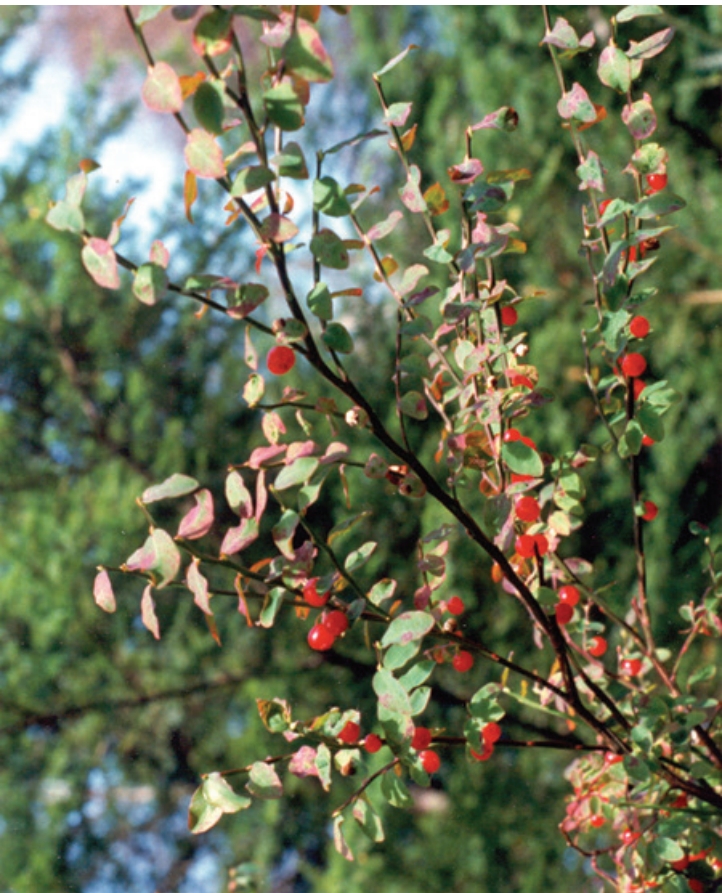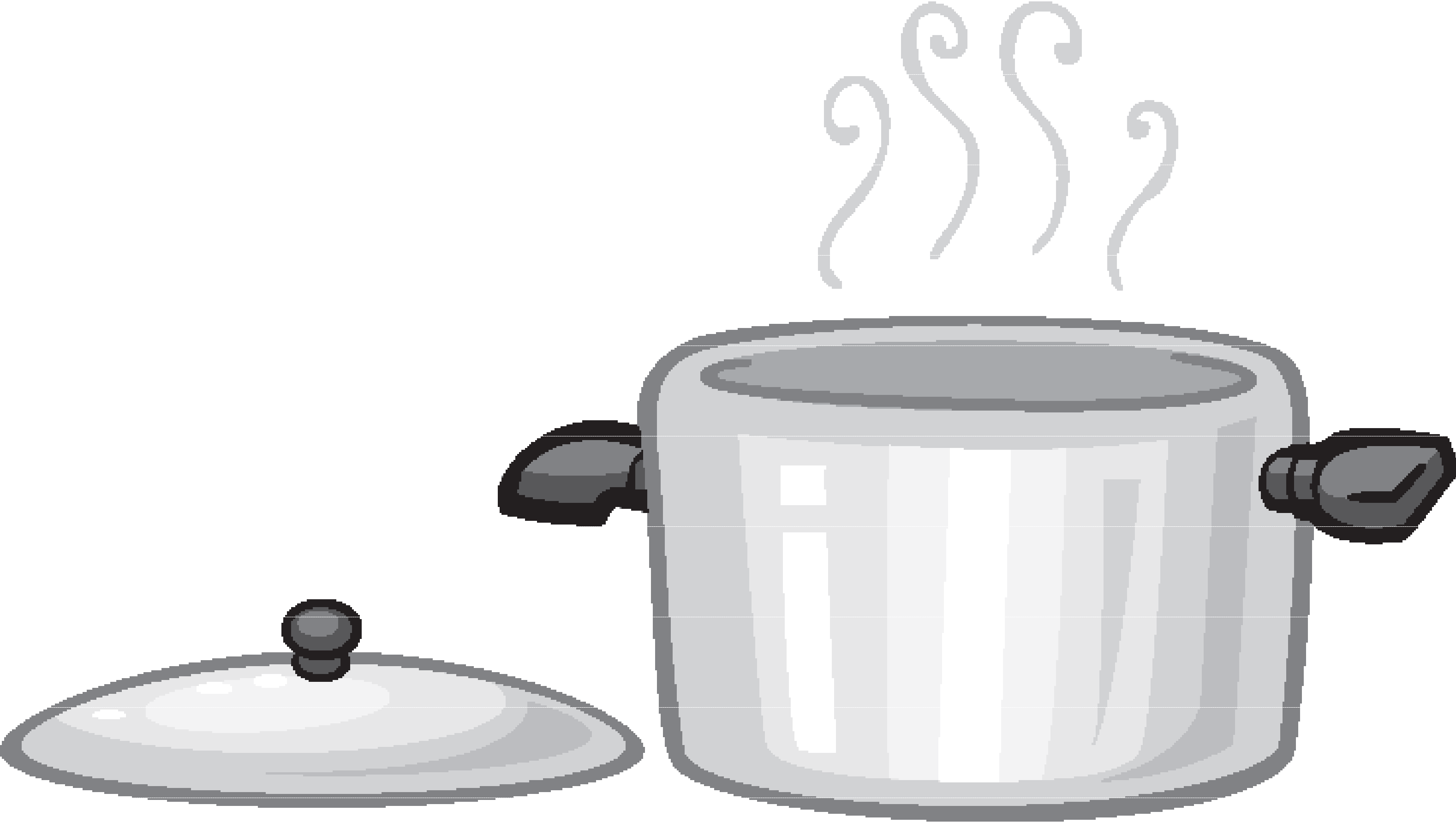Red Huckleberries
FNH-00107 View this publication in PDF form to print or download.
Red huckleberries are translucent, red, acidic berries that grow on diffusely branched shrubs up to 5 feet tall. The small, bell-shaped flowers are solitary in the axils of the leaves. Huckleberries are found on brushy, rocky hillsides of Southeast Alaska.
Red huckleberries are available in the fall. They make a superior jelly and may also be eaten raw or dried and used for jams, preserves, pies, muffins and puddings.
Storage and Preservation
How to Clean and Store
To clean huckleberries, spread a clean, dry terry cloth towel over a slanted surface, such as a cutting board, with one end propped up a few inches above the other. Gently roll the berries down the towel; most of the debris and leaves will cling to the towel, while the berries roll off. Huckleberries should be stored covered in the refrigerator and will keep up to one week.

How to Freeze
Arrange dry, fresh huckleberries in one layer on a cookie sheet and place in the freezer. When frozen, transfer berries to freezer bags or containers. Properly frozen, huckleberries will maintain good quality up to two years.
How to Dry
Select firm, dry huckleberries. To sun dry, cover a flat tray with cheesecloth or light muslin. Spread the berries on the cloth; place the tray in the sun. Dry in sun for two days, turning once or twice, then set tray in a warm, dry place and let huckleberries stand until leathery to the touch. To dry berries in a dehydrator, spread on an open screen and dry as for other berries, following directions for the dehydrator. Oven drying is possible, but very low heat (140 degrees F) must be used and the oven door must be left slightly open, with a fan placed nearby, so moisture can escape. Store dried berries in a cool, dry place. Use as you would raisins. Dried huckleberries can be soaked in water for use in baking.
How to Extract Juice
Combine 11 cups of huckleberries and 1 cup water. Crush berries. Bring to a boil and maintain a simmer for 10 minutes. Strain through a jelly bag or several layers of cheesecloth in a colander. Let the juice drip into a bowl. For clear juice, do not twist or press jelly bag or cheesecloth. For long-term storage, the juice should be frozen or water-bath canned.
Yield: 5½ cups
Hot pack for juice
Sterilize canning jars. Heat juice, stirring occasionally, until it begins to boil. Pour into hot jars, leaving ¼ inch headspace. Wipe jar rims. Adjust lids. Process in a boiling water canner.
- Quarts and smaller 5 minutes
- Half gallons 10 minutes
How to Prepare Puree
Cooked method: Add 1 cup of water to 4 cups of huckleberries. Cook until skins have popped. Press through sieve or food mill. Discard skins and seeds.
Yield: 2 cups
Uncooked method: Rinse 4 cups of huckleberries, drain, put in a blender and blend until the consistency of a thick puree.
Yield: 2 cups
To freeze, pack into rigid containers leaving a ½- inch headspace for expansion. Seal and freeze. To can, fill hot jars with hot puree, leaving 1/4-inch headspace. Process quarts or pints in a boiling water bath for 15 minutes. Purees can be processed in a dial gauge pressure canner for 8 minutes at 6 pounds pressure or at 5 pounds pressure in a weighted gauge canner.
Recipes
Huckleberry Syrup
- 1 cup huckleberry juice
- 2 cups sugar
- 1 teaspoon lemon juice
Combine huckleberry and lemon juices and sugar in saucepan; heat to 160 degrees F. Use a candy thermometer; do not boil. The syrup is ready to use over waffles, pancakes, hot biscuits, ice cream and other desserts. The syrup will keep up to six months in the refrigerator without crystalizing.
For long-term storage: Sterilize pint or half-pint canning jars and prepare lids; immediately pour hot syrup into hot canning jars, leaving ¼ inch headspace. Wipe jar rims and adjust two-piece lids. Process 5 minutes in a boiling water bath.
Yield: 2 cups
- To sterilize canning jars, boil in water for 5 minutes.
- To prepare two-piece lids (rings and tops), wash, rinse set aside until ready to use. Follow manufacture’s directions for use.
- If less sugar is desired in recipes calling for pectin, be sure to use no-sugar-needed pectin and follow the instructions on the box.
- See later instructions on this page for how to use a boiling water canner.
Huckleberry Applesauce Fruit Leather
- 1 cup huckleberry puree
- 1 cup unsweetened applesauce
- 1 tablespoons honey or corn syrup
Combine huckleberry puree, applesauce and sweetener. Line a cookie sheet with plastic wrap or use plastic leather tray in a dehydrator. Spread puree mixture evenly about ¹⁄8 to ¼ inch thick over plastic, but do not push it completely to the sides. Oven dry at 140 degrees F for approximately 6 hours, leaving oven door slightly open so moisture can escape. Or use a dehydrator and follow manufacturer’s directions for fruit leathers.
Yield: 1 sheet
Huckleberry Jelly, option 1
- 3½ cups huckleberry juice
- 1 package powdered pectin (1¾ ounces)
- 2 tablespoons orange juice
- 2 tablespoons lemon juice
- 4½ cups sugar
Sterilize pint or half-pint canning jars and prepare lids. Measure sugar and set aside. Measure huckleberry juice into a large saucepan. Add pectin and stir until dissolved. Add lemon and orange juices. Place on high heat; stir constantly and bring to a full rolling boil that cannot be stirred down. At once, stir in sugar. Again, bring to a full rolling boil. Boil hard for 1 minute, stirring constantly. Remove from heat and quickly skim off foam. Immediately pour jelly into hot canning jars, leaving ¼ inch headspace. Wipe jars rims and adjust two-piece lids. Process 5 minutes in a boiling water bath.
Yield: 6 cups
Huckleberry Jelly, option 2
- 4 cups huckleberry juice
- 7½ cups sugar
- 6 ounces liquid pectin
Sterilize pint or half-pint canning jars and prepare lids. Open liquid pectin pouch and stand upright in a cup or glass. Measure juice into a large saucepan. Stir in the sugar. Place on high heat; stir constantly and bring to a full rolling boil that cannot be stirred down. Add the liquid pectin and heat again to a full rolling boil. Boil hard for 1 minute, stirring constantly. Remove from heat and quickly skim off foam. Immediately pour hot jelly into hot canning jars, leaving ¼ inch headspace. Wipe jar rims and adjust two-piece lids. Process 5 minutes in a boiling water bath.
Yield: 7 cups
Huckleberry Jam
- 5 cups crushed huckleberries
- 2 tablespoons lemon juice
- 1 package powdered pectin (1¾ ounces)
- 4 cups sugar
Sterilize pint or half-pint canning jars and prepare lids. Measure sugar and set aside. Measure crushed huckleberries and lemon juice into a large saucepan. Add pectin and stir until dissolved. Bring to a full rolling boil over high heat, stirring constantly. At once, stir in sugar. Stir and bring to a full rolling boil that cannot be stirred down. Boil hard for 1 minute, stirring constantly. Remove from heat and quickly skim off foam. Immediately pour hot jam into hot jars, leaving ¼ inch headspace. Wipe jars rims and adjust two-piece lids. Process 5 minutes in a boiling water bath.
Yield: 5 cups
Huckleberry Muffins
- 1½ cups all-purpose flour ½ cup sugar
- 2 teaspoons baking powder ½ teaspoon salt
- 1 egg ½ cup milk
- ¼ cup vegetable oil ¾ cup huckleberries
Lightly oil muffin pans. In a bowl, measure and mix together flour, sugar, baking powder and salt. In another bowl, beat egg and add milk and oil. Pour liquid ingredients into dry ingredients. Mix dry ingredients until just moistened (about 15 mixing strokes). Batter should be lumpy. Fold in huckleberries. Fill muffin cups two-thirds full. Bake at 400 degrees F for 20 to 25 minutes or until golden brown. Immediately remove muffins from pans and cool on a wire rack.
Yield: 12 muffins
Huckleberry Pie
- 2½ cups huckleberries
- 1 teaspoon lemon juice
- 1 cup sugar
- dash salt
- 3 tablespoons flour
- pastry for double-crust, 9-inch pie (unbaked)
In a bowl, mix together huckleberries, sugar, flour, salt and lemon juice. Pour into pastry-lined pie pan. Cover with top crust. Bake for 15 minutes at 400 degrees F, then turn heat down to 350 degrees F and continue to bake for 30 to 35 minutes.
Huckleberry Cobbler
- 3 cups huckleberries
- ¹⁄3 cup sugar plus ½ cup sugar
- 2 tablespoons lemon juice
- ¼ cup margarine
- ¾ cup flour
- 1 teaspoon baking powder
- ¼ teaspoon salt
- dash cinnamon
- dash nutmeg
- ½ cup milk
Lightly grease an 8x8-inch baking pan. Combine huckleberries, ¹⁄3 cup sugar and lemon juice; pour into pan. In a bowl, cream margarine and remaining ½ cup sugar. In another bowl, sift together, flour, baking powder, salt, cinnamon and nutmeg. Add the flour mixture alternately with the milk to the creamed mixture. Pour over the berries in the pan. Bake in a 400 degree F oven for 40 minutes or until done.
Huckleberry Topping
- 4 cups huckleberries
- 1 cup sugar
- 1 cup water
- 1½ tablespoons cornstarch
Place huckleberries in a saucepan. Measure 1 cup water. Remove 2 tablespoons of the water to use with the cornstarch. Add sugar and remaining water to the huckleberries and heat to boiling. Make a thin paste of cornstarch and the 2 tablespoons of water and add slowly to huckleberries. Simmer 15 minutes or until thick. This topping is good on ice cream and it is an excellent dessert accompaniment for a one-layer cake.
Yield: 3 cups
UAF Cooperative Extension Service Resources
Jams and Jellies, FNH-00730
Canning Overview, FNH-00705
Using Alaska’s Wild Berries and Other Wild Edibles ($15), FNH-00120
Fruit Leather, FNH-00228
- Fill the canner halfway with water. Preheat water to a low boil. Place filled jars, fitted with lids, into the canner on the rack. Add more boiling water, if needed, so the water level is at least 1 inch above jar tops. Turn heat to its highest position until water boils vigorously. When the water boils, set a timer for the recommended processing time indicated in the recipe. Cover with the canner lid and lower heat setting to maintain a gentle boil throughout the processing time. Add more boiling water, if needed, to keep the water level above the jars.
- When the jars have been boiled for the recommended time, turn off the heat and remove the canner lid. Using a jar lifter, remove the jars and place them on a towel, leaving at least 1 inch of space between the jars during cooling.
- After cooling jars for 12 to 24 hours, remove the screw bands and test seals. Press the middle of the lid with a finger. If the lid springs up when finger is released, the lid is unsealed. If a lid fails to seal on a jar, remove the lid and check the jar-sealing surface for tiny nicks. If necessary, change the jar, add a new, properly prepared lid and reprocess within 24 hours using the same processing time. Alternately, adjust headspace to 1½ inches and freeze or store in the refrigerator and use within three days.
- If lids are tightly sealed on cooled jars, remove screw bands, wash the lid and jar
to remove food residue, then rinse and dry jars. Label and date the jars. Store
in a clean, cool, dark, dry place.

Sarah R-P. Lewis, Extension Faculty, Health, Home and Family Development. Originally written by Roxie Rodgers Dinstel, former Extension Faculty Health, Home and Family Development; and Marci Johnson, former Program Assistant, Health, Home and Family Development.
Revised November 2021
